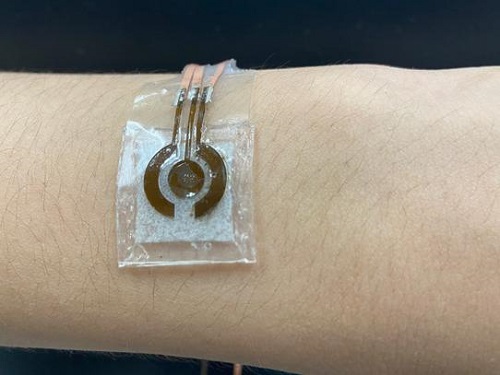Monitoring blood glucose is a pain(literally). People with diabetes often end up poking their fingers with painful needles as much as seven times a day! These work by analyzing a small amount of blood, usually from a fingertip. A lancet lightly pricks the skin to obtain the blood, then analyzed by an enzymatic sensor, and finally, a screen in the device shows the glucose levels to the user. Although these needles are not very painful, having to poke your fingers every day for several years can be frustrating.
As an alternative, researchers at the Pennsylvania State University (Penn State) have developed a non-invasive, low-cost wearable device. Unlike the traditional glucometers, these do not use a person’s blood to analyze their blood glucose levels. Instead, they use a person’s sweat to analyze their blood sugar levels.
The device is made of Laser-Induced Graphene (LIG) material which consists of atom-thick carbon layers with high electrical conductivity. Surprisingly, this LIG layer can be manufactured within seconds!
However, the LIG is not sensitive to glucose despite its high electrical conductivity. The researchers at Penn State deposited a nickel-gold alloy on the LIG to tackle the problem. Nickel-Gold alloy can detect deficient concentrations of glucose (100x more minuscule than the concentration in blood)
Seemingly, this Nickel-Gold alloy also has another benefit. It helps to lower the risk of a potential allergic reaction.

The enzymatic sensor used in the traditional glucometers has to be kept at a specific temperature and pH level. Also, it cannot be stored in the long term. On the other hand, a non-enzymatic sensor (like the LIG) can give accurate results in almost all working environments. Not everything about these non-enzymatic sensors is excellent, however. The LIG, for example, requires an Alkaline solution and hence cannot be used continuously for a long time. To tackle this, a small microfluidic chamber was attached to the LIG alloy that was connected to a collection inlet that passed sweat into the solution without allowing the solution to touch the skin.
The primary solution interacts with the glucose molecules to produce a compound that reacts with the Nickel-Gold alloy, which triggers an electrical signal, indicating the glucose concentration in the sweat. Since the microfluidic chamber is porous, it can easily bend and flex, thus making it comfortable to be attached to any body part. Along with the alkaline solution chamber, the entire device is about roughly the size of a quarter while being flexible enough to attach to the human body securely.
However, it is still far away from when it completely replaces the traditional glucometers that rule the market today. Medical Equipment, especially those where a lack of accuracy or precision can be fatal, needs to undergo a lot of testing and scrutiny before being made available for the general public.
Since the device uses a person’s sweat to analyze their blood glucose levels, it fails to work with no sweat. This is a significant problem. People cannot be expected to do a workout before every measurement. It would be highly inconvenient and frustrating. What about medical emergencies where both time and accuracy are essential? It would not make sense to use these devices in such scenarios.
The device is still a work in progress. The research team at Penn State intends to improve this device over time. The team also wishes to refine and expand this platform for more comfortable monitoring of other biomarkers present in the sweat or interstitial fluids that fill the space between cells in the body.
This glucose sensor serves as a foundational example to show that we can improve the detection of biomarkers in sweat at extremely low concentrations. Although still a work in progress, Non-Invasive Glucometers have huge potential.



